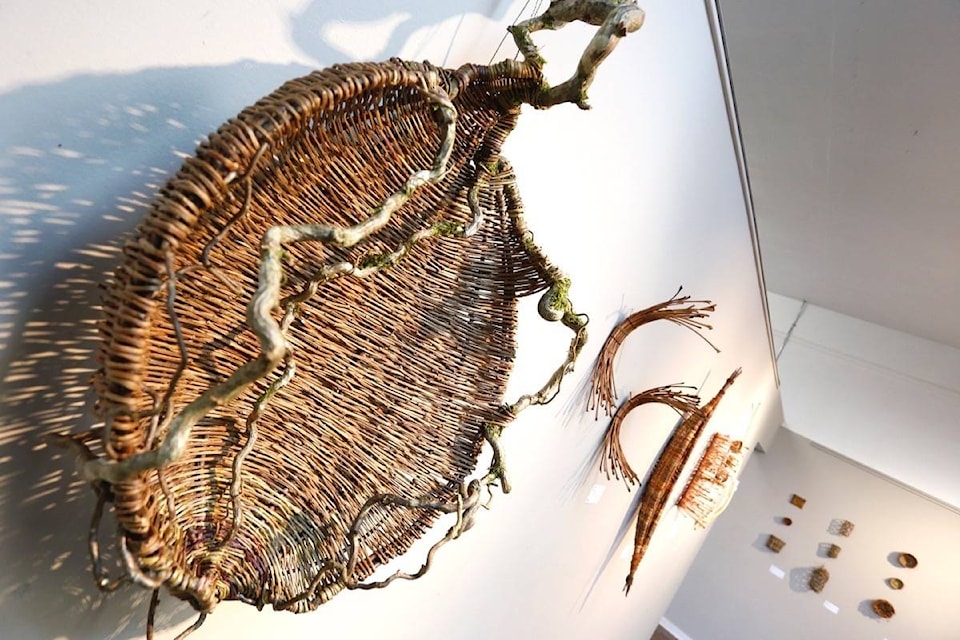You know that weed you’re pulling out of your garden, or that invasive vine that’s taking over a nearby tree?
Though they can be blights to front yards and forests alike, to Christi York, they can also be materials for her next art piece.
York is currently showing her first gallery exhibit at the MAC (McMillan Arts Centre, 133 McMillan St., Parksville) featuring what she’s dubbed “contemporary basketry”.
It’s a unique, three-dimensional exhibit showcasing her art baskets made from local plant materials she’s sourced, harvested and processed herself.
A combination of both ancient technology, modern aesthetics and a repurposing spirit, York said she hopes her work inspires people to consider the plant world in a new way.
She certainly did upon learning basketry.
York’s artistic career started out in graphic design, but she eventually moved on to making things by hand as a way to get away from computers, and then moved on to jewelry-making.
“I had a fairly successful jewelry line in Vancouver for about 10 years… using up-cycled materials like vintage metals and re-working them,” said York.
“I was very, very intrigued with that sort of trash-to-treasure kind of angle,” she said. “Those (vintage pieces) were sort of overlooked and laying in thrift stores and in old antique warehouses for years until you look upon them with a new set of eyeballs and see what can be done with it.”
After years of working with jewelry, York found a new direction with environmental artist Sharon Kallis.
“She got hooked up with the parks board in Vancouver, so what she was doing was using the waste from the parks board, meaning all the material that’s culled out of the parks like invasive species specifically is pulled out by the ton, and she’s looking at that material going, ‘Well how can I use this in replacement of a sort of a traditional basketry material?’”
That method really hit home for York, with her trash-to-treasure interest.
“She was the one who introduced me to the idea of using, basically what it comes down to is free art material. That’s one way to look at it.”
All it took was being taught how to build things with that free material, said York. “I was absolutely hooked.”
“Sharon taught me how to make cordage which is basically rope. The simplest little rope is twisting two fibres together, and boom, you have string,” said York.
Being taught this and other techniques, as well as learning about various plants, how they can be ethically harvested and what they can be used for, gave York a new way of seeing the natural world on Vancouver Island.
Born in Victoria, York spent 20 years in Vancouver but is now back on the Island, living in Duncan.
“I’m intimately familiar with the basic kind of flora and fauna that are here in front of me,” she said.
“But it wasn’t until I started working with fibre that it really opened my eyes to what can be used, yes, but also just to plant identification: learning so much about plant identification, about native species and invasive species, just through basketry and learning what you should be using, what you can use, maybe what you shouldn’t use, what, if anything, is over-harvested, responsible harvesting, all that kind of stuff.”
“It’s like having new eyeballs,” she said.
For the past four or five years, York has been working on natural fibre basketry, culminating in this first exhibit.
It includes baskets in a variety of sizes and odd shapes, some woven right around larger branches that the baskets hang off of like fruit, while others take on the overall shape of canoes, and more.
York said that her inspiration for her pieces come from a variety of places, including her modern aesthetic, the work of other basketry artists she sees online, and the use of natural materials.
Her work in the show makes use of contorted hazel, Virginia creeper, basketry willow, peeled maple and peeled English ivy and more, with much of the materials harvested from friendly gardeners.
But sometimes inspiration comes from further away.
“I saw something on an Australian basket-makers Instagram, and I was like, ‘What is that material?’… It looks sort of like chicken bones.”
After contacting the artist, York was told the material is from a particular type of plant not available on Vancouver Island.
“But I studied it and I thought, ‘You know, if you pull the leaf off of a maple stem, you’d have something kind of similar.’ So I started collecting big leaf maple stems, and that led to three pieces in this show,” said York.
Of the show as a whole, York said she hopes it gives people time to pause and consider the plant world in a new way: that people might realize that, not long ago, not only did people know how to make things like these baskets and use them, but that they relied on these plants for these materials.
“Working with nature and not against it is what it comes down to… We’re all connected that way.”
York’s exhibit at the MAC continues until Feb. 24.
